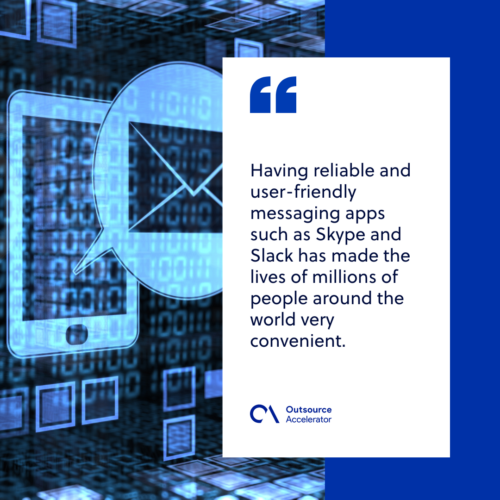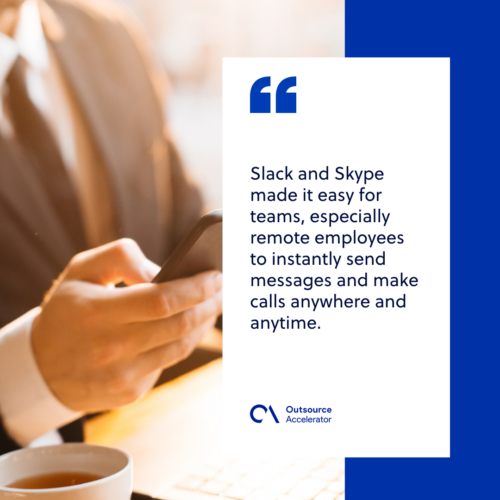Skype vs. Slack: Which one is better for your business?

Having a team communication platform is crucial for all businesses, especially during the pandemic, when teams work remotely.
As a manager or a business owner, you want your team members to get all of your notifications and messages on time.
With fast and reliable instant messaging, teams can collaborate on projects and share files much more easily.
That’s why Skype and Slack are the most talked about when it comes to team chat apps.
The debate over which is better, Skype or Slack, has been the question for many businesses for over a decade.
Let’s read on and discover if Slack vs. Skype is better for your business.
The business world’s increased reliance on communication apps
No matter what industry you are in, whatever your organization’s size is, technology opens many doors to optimize production beyond what you could do without it.
The technology that brought us communication apps lets us communicate with various people around the globe.
Businesses are closer to their clients, which increases their ability to personalize customer service. Moreover, communication apps made it possible for employers to enforce operational efficiency on their remote workers.
Having reliable and user-friendly messaging apps such as Skype and Slack has made the lives of millions of people around the world very convenient.
Add to that the constant advancement of smartphones and laptops where these apps can be accessed, and it’s now much easier for humans to communicate, especially for work.

The ability to instantaneously send messages between colleagues has been the primary function of these two most used messaging apps—Skype vs. Slack.
These two have become the yardstick for the most beneficial tool for office communications.
Communication and collaboration in the business world wouldn’t be possible without businesses’ reliance on messaging apps.
That’s why programs like Skype and Slack have increased usage in the market.
As of 2023, Slack prides itself on its 19.2 million users per day, while Skype reported that they have 300 million monthly users.
Skype vs. Slack: Main features comparison
Slack and Skype made it easy for teams, especially for remote employees. They can send messages and make video and audio calls anywhere and anytime.
But if you’d like to know which one is better for your business.
Here are the comparisons between the two apps:
Interface (messaging and calls)
When it comes to their primary functions, which are messaging and calls, Slack offers one-on-one and by-group direct messaging, as well as audio and video calls via multiple channels.
Meaning conversations can happen in both separated and integrated chat rooms. These rooms can be created for any need.
Teams can compartmentalize certain conversations, allowing them to organize their tasks. You can even message yourself to set up a to-do list or take notes if you want a reminder for your task or deadline.
On the other hand, Skype allows participants to communicate instantaneously, and audio and video calls can be made one-on-one and in groups, too.
Skype will also allow you to screen-share presentations for your discussion if you are in a group meeting with your colleagues.
You can also record the whole call or video meeting in case you want to replay it for review.
Price and packages
The basic version of Slack is free, but it has its limitations. The free version allows you to have all kinds of calls. You can still send messages to multiple people and create a single channel for your conversation.
Slack Pro package starts at $7.25 per month if billed yearly and $8.75 per active user per month when billed monthly. This paid subscription includes group calls, unlimited channels, and better security.
They also have Slack Business, which costs $12.50 per month when billed yearly and $15 per month if billed monthly.
This package includes more advanced IT features, 24/7 support, and 99.99% guaranteed uptime SLA.
All communication on Skype with 100 people is completely free. It can also be downloaded for free, providing basic messaging and calls to your team members who are also on Skype.
So, if you’re not aiming for other features and need instant communication, feel free to use Skype. But if you want more features, you can also buy Skype credit or Microsoft Skype for Business with an annual fee of $99.99.
This plan includes Microsoft Office, Microsoft Exchange, and Microsoft SharePoint. Their entry-level plan starts at $6.00 per month.
It includes instant messaging, audio, and HD video calling to Skype participants.
Team collaboration and integration
Slack makes it easy to collaborate and categorize tasks due to its channels. It allows users to easily share all files simply by dragging and dropping them into the app.
Users can also connect Slack to file-sharing apps like Google Drive and Dropbox.
Aside from file-sharing, Slack can be integrated with video meeting apps like Zoom. You can use this feature to add calendar apps to schedule meetings so that you’ll be reminded every time you have one.

Skype, on another note, offers the benefits of Microsoft features during calls. If you buy one of the Office 365 plans, you’ll also get access to Outlook, Notes, and other famous apps to integrate with the app.
Its integration with the Office suite makes it easy for teams to meet and discuss, including screen sharing and the ability to record meetings.
Both Skype and Slack, as collaboration tools, allow you to attach files, photos, videos, GIFs, voice messages, and the like. You can do this one-on-one or by group.
Skype vs. Slack: Which app fits you best?
When it comes to choosing between Skype and Slack, it all boils down to what suits your needs and preferences.
Both apps are geared towards communication, but they have their own unique strengths.
Skype has been around for a while and is great for video and voice calls. It’s a solid choice if you need reliable, high-quality conferencing for larger groups.
On the other hand, Slack is all about team collaboration.
It organizes conversations into channels, making managing different discussions and projects easier for your team.
So, which one fits you best?
If you’re looking for seamless video conferencing, Skype might be your go-to. But if team collaboration and project management are your priorities, Slack could be the better fit.
Ultimately, it’s about what aligns with your communication style and business needs.







 Independent
Independent




